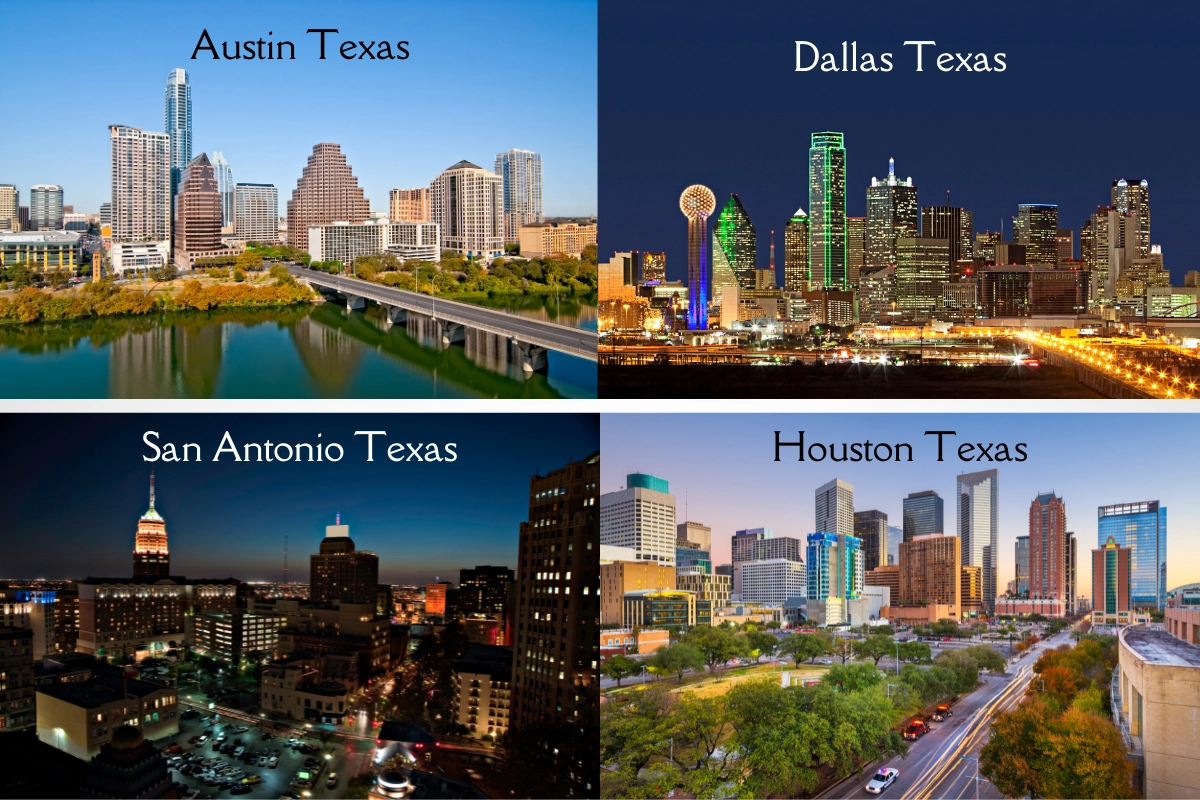Get a deeper understanding of Texas cities’ demographics with this informative guide. Our Cities in Texas series allows you to take a deeper look at some of our Texas cities A-Z, both big and small. Read on to see overview of the cities in Texas demographics, various areas, culture, income, economics, population, future outlook. Then click on any letter to find our more!
Cities in Texas A-Z
A B C D E F G H I J K L M N O P Q R S T U V W X Y Z
Thinking of moving to Texas. Jump to our Texas Lifestyle mortgage calculator here.
Looking for Texas Resources and Benefits, jump here.
Texas Cities Demographics: Key Trends and Insights
Learn about the diversity, income, and population trends of major cities in the Lone Star State.
Read about Texas Health Benefits and resources here.
Texas is a diverse state with a variety of cities that offer unique cultural experiences. Understanding the demographics of these cities can provide insight into the people who call them home. From the bustling metropolis of Houston to the laid-back vibe of Austin, learn about the diversity, income, and population trends of major Texas cities in this informative guide.
Introduction to Texas Cities Demographics
Texas is a state known for its diversity, and this is reflected in the demographics of its major cities. From the large and diverse population of Houston to the rapidly growing tech hub of Austin, each city has its own unique characteristics. Understanding the demographics of these cities can provide valuable insights into the people who call them home and help businesses and organizations better serve their communities. In this guide, we will explore key trends and insights into the demographics of major Texas cities.

Diversity and Ethnicity in Texas Cities
Texas is a state with a rich history of diversity, and its major cities reflect this. According to the U.S. Census Bureau, Houston is the most diverse city in Texas, with a population that is 44.5% Hispanic, 23.7% White, 22.5% Black, and 7.2% Asian. Dallas is also a diverse city, with a population that is 41.7% White, 29.1% Hispanic, 24.3% Black, and 4.5% Asian. Austin, on the other hand, has a population that is 48.7% White, 33.7% Hispanic, 7.5% Black, and 6.7% Asian. Understanding the diversity and ethnicity of these cities can help businesses and organizations better serve their communities and create more inclusive environments.
Income and Economic Trends in Texas Cities
In addition to diversity, understanding income and economic trends in Texas cities is important for businesses and organizations. According to the U.S. Census Bureau, the median household income in Houston is $51,579, while in Dallas it is $50,431. Austin has a higher median household income of $71,543. However, it’s important to note that income inequality exists in all three cities, with certain neighborhoods and populations experiencing higher poverty rates and lower incomes. By understanding these trends, businesses, and organizations can better tailor their services and outreach efforts to meet the needs of all members of the community.
Population Growth and Migration Patterns in Texas Cities
Texas cities have experienced significant population growth and migration patterns in recent years. According to the U.S. Census Bureau, Houston is the fourth largest city in the United States, with a population of over 2.3 million people. Dallas is the ninth largest city, with a population of over 1.3 million people. Austin, while smaller in size, has experienced the fastest population growth of any major city in the country, with a population increase of over 20% between 2010 and 2019. This growth has been driven in part by migration patterns, with many people moving to Texas cities from other states and countries in search of job opportunities and a lower cost of living.
In Conclusion, Cities in Texas Series and Future Outlook for Texas Cities
In conclusion, the Cities in Texas series shows how the Lone Star State is both diverse and growing rapidly, with significant population increases and migration patterns in recent years. While this growth has brought economic opportunities and a lower cost of living for many, it has also presented challenges in terms of infrastructure, housing, and social services. As Texas cities continue to grow and evolve, it will be important for policymakers and community leaders to address these challenges and ensure that all residents have access to the resources and support they need to thrive.
Thinking of moving to Texas? Check out our Texas Cost of Living and mortgage calculator here.
Texas Resources
Read more about Texas Health Benefits and resources here.
Read more about Texas Resources and Support here.
Austin Texas barbecue barbeque bbq cities in texas cost of living in texas cost of living texas cost to live in texas foods from Texas Foods in Texas friendly people google abandoned texas google texas county google texas news google texas roadhouse google texas weather leading texas lifestyle brand life in texas lifestyle brand living cost texas living in Texas living texas local texas moving to texas San Antonio Texas Space X Texas Texas BBQ Texas Chili texas cooking texas cost of living texas culture texas food Texas Hill Country Texas Life Texas Lifestyle Texas life style texas lifestyle brand Texas Lifestyle influencer texas live Texas living texas living cost Texini the leading Texas lifestyle brand texmex Tex Mex
The Texas state motto “Friendship” was chosen because of the historical significance of the term for Texans. It represents the friendly relationship between the Native American tribes and the early settlers, as well as the strong bond between Texans during the fight for independence. It also reflects the welcoming and hospitable nature of Texans towards visitors and newcomers.



